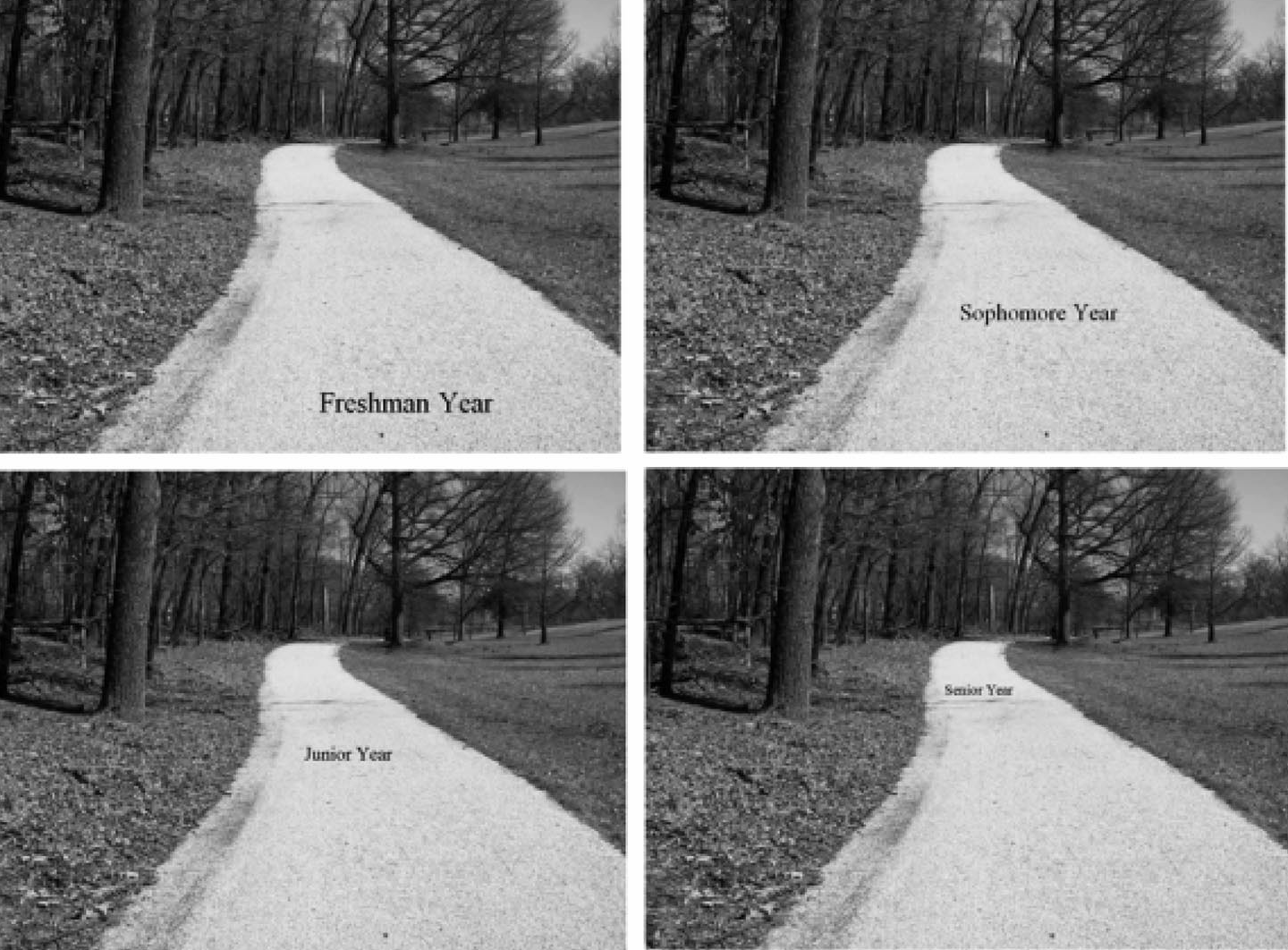
This post is based off an interesting recent article by Landau, Oyserman, Keefer, and Smith (2014) that looks at how journey-based metaphors can help individuals connect their image of their current self with their future self. The current self is essentially who and where we are at this moment, while the future self is who we want to be, including any particular goal we are trying to reach. The more connected we are with our sense of selves, the more likely certain outcomes such as student engagement and academic success are obtained. This article describes a series of studies that were conducted to explore how framing a person's identity metaphorically, as a destination on a journey, leads them to feel more connected to their identities, while also engaging in those actions necessary to attain it. Don't worry, these ideas are better explained in the paragraphs to follow!
First, let's consider this possible scenario: a first year college student is determined to graduate as a chemistry major in four years. When the student thinks of this version of her future self as a chemist, she sees an image of what she would be like and how she would be behaving (e.g., holding a degree, obtaining a job in the field, and being capable of carrying out her job tasks). She also has an image of her present academic self, which includes all the potential bad (or good) habits that might prevent her from reaching her future self (being unfocused in her schoolwork, skipping class, forgetting ot hand in assignments, not having any experience in the college setting since she's new to that environment). How does she take her current academic self and connect it to the graduated chemist she strives to be?
I'm sure we all have different versions of future selves we strive for, in many different settings. But (as I'm also sure we've all experienced) just having this image does not necessarily translate into actually initiating the actions that will get us to our goals. Most of us need something to bridge our present self with our future self, a call-to-arms so to speak, which is what this research explores: what happens when we apply journey-based metaphors to a goal that we want to reach? In other words, what happens when we emphasize the path we must actively take to reach our goal in a metasophical sense?
Journey-based metaphors
Colleges frequently use journey-based metaphors for events (like student orientation) to describe academic success as a path or journey that students will embark on. Such phrases as, "You are about to begin the journey of undergraduate education" (Carnegie Mellon University) or "what happens if you hit a roadblock" (University of Hawai'i) are metaphors for how to get through (i.e., graduate) higher education. Of course, we know college is not literally a journey or a path through which one encounters actual roadblocks, and that academic tasks, such as studying for tests and writing papers, are physically unlike the navigation of a real-life rocky terrain. But when these phrases are used to frame a person's identity, journey as metaphors seem to encourage the actions necessary to reach our "future self".
It is not only colleges who frame goals with the journey as metaphors approach. Many advertisements persuade consumers to embark on a journey (by purchasing their product) to a healthier/happier/more attractive self (Agnes, 2009, as cited by Landau et al, 2014). Politicians and leaders, like Winston Churchill, Barack Obama, and Martin Luther King Jr. use this method as well for such purposes as rallying civic action by describing physical journey (Landau et al, 2014).
An example of a visual metaphor used in this research are when a student is prompted with a sequential journey-framed path, as displayed in Figure 1. Starting with Freshman year, students are asked to form a mental image of themselves in that year, focusing on their academic traits and accomplishments. Then the student is prompted with the next image (second photo on the top right) and asked to do the same mental exercise for their Sophomore year. This continues until the Senior year, when the student is presented with this prompt: Imagine yourself during your Senior year. Visualize yourself as having achieved all of your academic goals. Imagine that your experience in classes has gone as well as it possibly could have, and that you have performed extremely well academically. In the space below, write a few sentences describing this image of yourself during your Senior year. What are you like, and what do you see yourself doing? Describe how you feel in this imagined scene. Try to create a vivid picture of the "academic you" in your Senior year.

Figure 1. (Landau, et al, 2014) Sequential journey framed path.
Less effective examples of metaphors would be thinking of your goal or future self as being located in a separate, bounded container. An example might be our chemist student from earlier who visualizes her future graduated chemist self being located inside a treasure chest. When we isolate our future goals from our current goals, we have a harder time taking actions to get us to that goal because it lives in the future and not the present.
Figure 2. (Landau, et al, 2014) Images used in the journey-metaphoric (left) and container-metaphoric (right).
Study Results
Seven studies were carried out by researchers Landau, Oyserman, Keefer, and Smith (2014). Studies 1-3 looked to see what the effect of metaphor use had on students' engagement with their academic identity as successful academic graduates. Study 1 found that students who used the goal-as-metaphors showed higher academic intent (intention to study operationalized through scheduled study time in hours) and study 2 found the same result when looking at academic effort (operationalized as exam performance).
Takeaway points: Students who used the goal-as-metaphor approach planned more time to devote to studying, and put in more effort to completing exams and difficult problem solving questions. Study 3 found that these positive outcomes lasted even a week later when students were taking final exams.
Studies 4-7 looked at the procedural processes that occur in conceptual thinking. What is it about the metaphor that works? When conceptualizing a goal as a journey metaphor, the goal then takes on a clear procedure of how to reach the ending result. Often in life, our goals are not very clear, and the journey does not follow a clearly defined route. If we are able to symbolize our goal in a way that outlines how we need to get there, we are left with a more solid impression of what it takes to reach that goal.
Takeaway points: The result of study 4 found that people who used the journey metaphor had more procedural confidence (they were confident they knew what steps to take) to reaching their current and future academic self (meaning, they knew where they were now, where they wanted to be, and how to tie those two together).
How does all of this connect to student engagement? Studies 5 and 6 look at academic engagement with two different populations: freshman college students who focused on their academic identity (study 5), and adults who focused on a desired identity 4 years in the future (study 6). The hypotheses for these studies were that by framing one's identity with the journey metaphor approach, individuals would be more engaged due to the fact that they were more closely connected with their identities. Results of both studies found increased engagement for the journey as a metaphor approach.
What does this mean?
Colleges who use the journey metaphor approach for student orientation campaigns might benefit from increased academically engaged students. Even more so, finding ways to incorporate this approach more specifically into students' lives might be even more beneficial. Helping students to set this approach up in an organized system (like OOHLALA's schedule) and through tools that support strong study habits (for example, OOHLALA's study timer) has strong implications for improving students' academic intent, engagement, and effort, thus resulting in overall improved academic outcomes. Perhaps embedding this research into OOHLALA app functions is a path (ha!) we will embark on.
I think I adapted the Journey-based metaphor. Correlating a place with a destination makes a person feel that there is conclusion. That there is life after this grueling phase which makes one persevere. All these college metaphors provide motivation. Layce of research paper writing.
ReplyDeleteWhat's even more comfortable when you are entertaining after a day of hard work.
ReplyDeletefriv 3